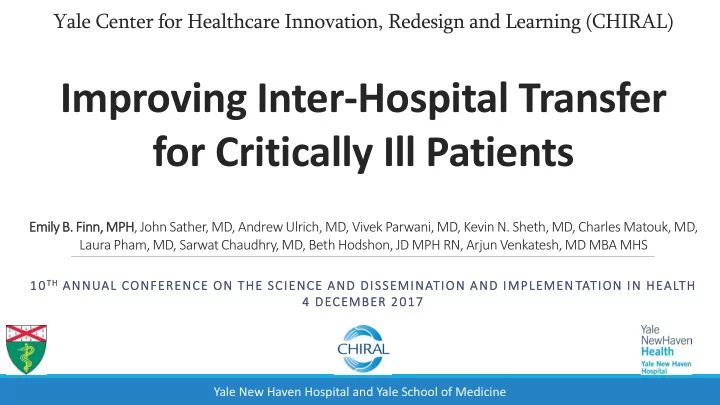

Yale Center for Healthcare Innovation, Redesign and Learning (CHIRAL) Improving Inter-Hospital Transfer for Critically Ill Patients Emily B. Finn, MPH, John Sather, MD, Andrew Ulrich, MD, Vivek Parwani, MD, Kevin N. Sheth, MD, Charles Matouk, MD, Laura Pham, MD, Sarwat Chaudhry, MD, Beth Hodshon, JD MPH RN, Arjun Venkatesh, MD MBA MHS TH ANNUAL CONFERENCE ON THE SCIENCE AND DISSEMINATION AND IMPLEMEN TATION IN HEALTH 10 TH 10 4 DECEMBER 2017 Yale New Haven Hospital and Yale School of Medicine
Acknowledgements Data were collected through the Yale Center for Healthcare Innovation, Redesign and Learning (CHIRAL). This research was supported by a grant (#P30HS023554-01) from the Agency for Healthcare Research and Quality (AHRQ) and receives support from Yale New Haven Hospital and the Claude D. Pepper Older Americans Independence Center at Yale School of Medicine (#P30AG021342 NIH/NIA). The content is solely the responsibility of the authors and does not necessarily represent the official views of these organizations. @Yale_CHIRAL 2
Background Patients diagnosed with intracranial hemorrhage at a community Who hospital and transferred to Yale What Inter-hospital transfer (IHT) via Yale Emergency Department (ED) Why IHT confers unique risk When January 2016 - present @Yale_CHIRAL 3
Project Partners Investigator Team Additional partners • Emergency Medicine (EM) • Community hospitals • Neuro-intensive care unit (NICU) • Diagnostic Radiology • Neurovascular surgery • Pharmacy • Y-Access (Yale IHT coordination center) • Blood Bank • Transport teams • Hospital IT/communications @Yale_CHIRAL 4
Project Goals 1. Define the baseline transfer process 2. Develop and implement an intervention @Yale_CHIRAL 5
Problem Analysis
Mixed methods approach Content Semi- Real-time Retrospective Process analysis of structured clinician chart review mapping transfer interviews surveys (n=1338) (n=17) requests (n=32) (n=138) (n=26) @Yale_CHIRAL @Yale_CHIRAL 7
Three challenges identified Gaps in clinical Insufficient knowledge and practice communication Lack of structure / “system” @Yale_CHIRAL @Yale_CHIRAL 8
Intervention
Collaborative design Investigator team developed intervention bundle Bundle proposed to Bundle refined stakeholders Feedback solicited @Yale_CHIRAL 10
Multi-modal intervention Order set added to EMR Statewide ED-based alert Transfer acceptance clinical guidance protocol process redesign dissemination EMR call-in template redesign @Yale_CHIRAL 11
Comprehensive evaluation Meetings Case-by-case with audit and stakeholders feedback EMR-based dashboard @Yale_CHIRAL 12
Early results show improvements Median time from ED arrival to admit order, in minutes 108.5 72 64.5 63 57 51.5 47.5 33 Timeliness of care 30 23 5/10/17: intervention launched February March April May June July August September October November (n=8) (n=12) (n=16) (n=11) (n=13) (n=12) (n=22) (n=10) (n=16) (n=13) “I had spoken to the ED before the patient “NS resident in ED waiting for patient Interdepartmental arrived and asked them to initiate blood arrival. Immediate read of community pressure control with nicardipine and hospital CT. Near immediate CTA. collaboration obtain a CTA CTV on arrival” (Neuro Admitted to NICU within 30 minutes.” resident) (ED attending) @Yale_CHIRAL 13
Implications for D&I research
Reflections D&I research may benefit from a focus on end- users’ perceptions of problems and solutions Early and regular leadership engagement and sponsorship is essential Multi-modal approach can be time-intensive but engages broader range of end-users QI initiatives live within the broader culture, are difficult to change processes for a subset of patients Clinically focused process improvement is more engaging for clinicians @Yale_CHIRAL 15
Recommend
More recommend